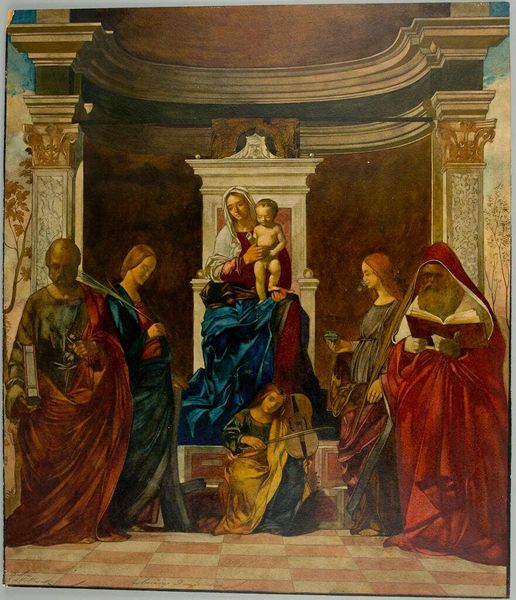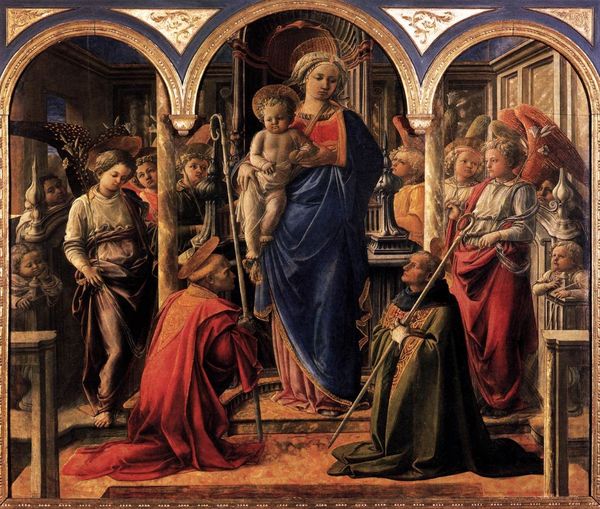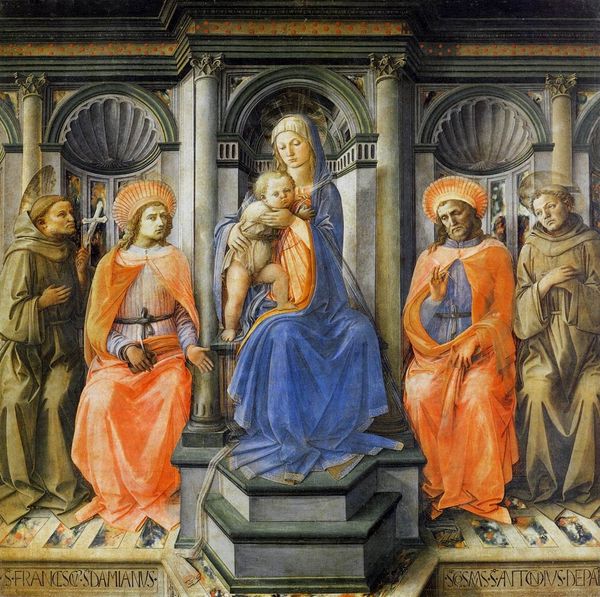
painting, oil-paint
#
portrait
#
venetian-painting
#
narrative-art
#
painting
#
oil-paint
#
figuration
#
classicism
#
christianity
#
history-painting
#
italian-renaissance
#
christ
Dimensions: 500 x 235 cm
Copyright: Public domain
Curator: Before us hangs Giovanni Bellini’s "San Zaccaria Altarpiece," completed in 1505. Painted in oil on canvas, this is a powerful example of Venetian Renaissance art. Editor: My initial reaction is one of profound stillness. The colors, while vibrant, create a serene atmosphere, and the composition—particularly the use of architecture—confines the figures, producing a sense of peaceful enclosure. Curator: Absolutely. And that tranquility can be situated in the context of Venice at the turn of the 16th century. The Republic was experiencing relative peace and prosperity, factors influencing the themes Bellini was inclined to explore, focusing on humanist perspectives of faith and devotion. Notice the gentleness of the Madonna as a reflection of burgeoning maternal societal roles, along with the figures of saints whose inclusion speaks to the era’s intellectual focus on theological teachings. Editor: I see your point. It's less about grand narratives and more about the subtle relationships between figures and architectural space. The light, for example, doesn't strike dramatically. Instead, it envelops each form, subtly defining its edges, and creating a sense of unity across the picture plane. Note how the artist constructs pictorial harmony and clarity. The arrangement, balanced composition, and subdued coloring contribute to the effect of visual equilibrium. Curator: Precisely. The architecture functions almost as a stage for the figures, framing their interactions and inviting us to contemplate the divine within a distinctly human context. Also, one should consider who might be considered on the fringes. The female saints are clearly defined in Bellini's narrative as active participants, challenging previously stringent religious and social structures which is rather progressive for the era. Editor: But beyond its sociopolitical resonance, let's not ignore the ingenious artistic manipulation occurring right before our eyes. The faux marble pillars framing the subject are rendered so believably that viewers almost expect to touch them! Moreover, the artist’s skill can also be detected when studying perspective and linear design; through expert application, the illusion of three-dimensionality enhances spatial immersion and compositional profundity within a confined domain. Curator: I find it so powerful how Bellini brings together humanism and spirituality. In examining his technical accomplishments, such as natural light and masterful technique, it also demonstrates how gender, faith and individual experiences reflect the world in which Bellini created his masterpiece. Editor: It seems the longer we linger on this painting, the richer its meaning becomes. It's proof that careful observation of color and form can reveal the timelessness and universal human ideals that exist on both canvas and history itself.
Comments
No comments
Be the first to comment and join the conversation on the ultimate creative platform.













